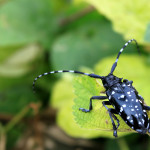
This week is the annual observance of National Invasive Species Awareness Week (NISAW). Around the country it is being observed through citizen participation in local programs that are as diverse as invasive species themselves. Invasive species problems are so ubiquitous and often locally so overwhelming, that some consider their management to be a hopeless and endless task. But that is not the case. While, to paraphrase the Irish politician John Philpot Curran, the price of a healthy ecosystem may indeed be eternal vigilance, ridding ourselves of invasive species is by no means a hopeless task.
Communities in the northeast have regularly successfully eliminated Asian long-horned beetle infestations, that would otherwise threaten to devastate our northern hardwood forests, and the Fall foliage that so colorfully characterizes New England autumns. In Florida, what was once the seemingly impossible task of controlling melaleuca, in fact is well under way by several modest-looking imported insects. In the West, another transplanted insect is taking on invasive tamarisk, and helping to restore riparian areas that have been overgrown with this invasive species for decades.
On the horizon is a biocontrol for zebra mussels, the arch-enemy of aquatic ecosystems and industrial facilities that use or discharge water. In the meantime, USDA is getting ready to test a native microbe that seems to have an affinity for killing cheatgrass, the fire-prone plant that has threatened the integrity of rangeland ecosystems for a century. Cheatgrass is also now one of the prime causes for the predicament of the greater sage grouse, whose listing under the Endangered Species Act would be incredibly disruptive to the Western economy. See The Weed that is Whipping the West. On a landscape scale, the State of Nebraska has dramatically reduced the percentage of its land that is infested by invasive weeds, proving that good planning coupled with intensive and well-coordinated management can prevail.
So whether you are celebrating NISAW by pulling some weeds in your backyard, visiting your local park, attending a scientific seminar, or just reading this blog, be of good cheer. We can, with a properly funded and motivated effort, and old-fashioned American ingenuity, protect and restore our ecosystems from the damage posed invasive species.
***
Please visit Reduce Risks from Invasive Species Coalition for more information on how you can help control the spread of invasives.

